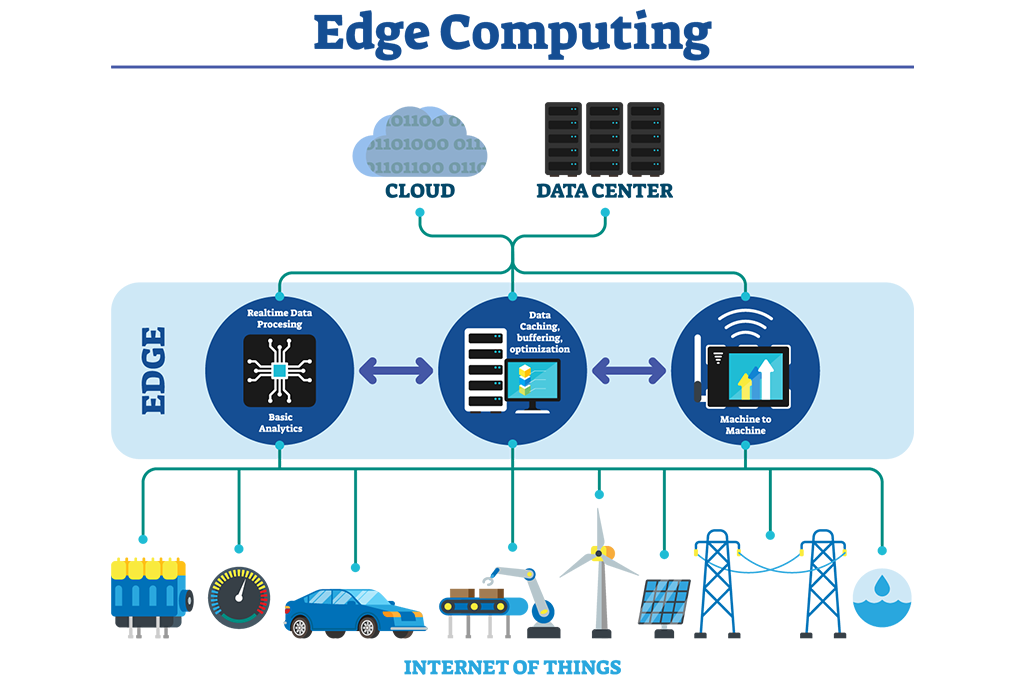Exploring the Advantages of Edge Computing
Edge computing is a cutting-edge approach that brings data processing and storage closer to devices and sensors at the network's edge. Instead of relying on a centralized cloud or data center for analysis and processing, edge computing empowers localized processing and decision-making at the edge.
Edge computing is closely linked to the Internet of Things (IoT) and is commonly employed in scenarios where real-time processing of large volumes of sensor data is required. It empowers edge devices to function autonomously, perform local analytics, and collaborate with other edge or cloud resources to deliver efficient and intelligent services.

Did you know edge computing provides several advantages?
- Reduced latency: Edge devices process data locally, eliminating the need for time-consuming round trips to distant cloud servers. This substantially reduces processing and response delays, making it ideal for time-sensitive applications.
- Bandwidth optimization: Edge computing reduces the volume of data that needs to be transmitted over the network to the cloud or data center. Only relevant data or processed insights are transmitted, optimizing bandwidth usage and reducing network congestion.
- Improved reliability: The system becomes more resilient to network failures or disruptions by distributing processing and storage capabilities across edge devices. Even if the connection to the central cloud is lost, edge devices can operate autonomously.
- Enhanced security: Edge computing bolsters data security by keeping sensitive or critical information within the local environment. Instead of transmitting data over the network, it can be processed and stored locally, minimizing exposure to potential security risks associated with data transmission.
- Scalability and flexibility: Edge computing enables scalability and adaptability in dynamic environments. As the number of edge devices grows, computing power and storage can be distributed across the network to meet changing system demands.
- Real-time analytics and AI: Edge computing facilitates real-time data analysis and decision-making at the edge, reducing reliance on cloud resources. This is particularly valuable in applications like autonomous vehicles, industrial automation, and remote monitoring, where instant responses are crucial.
An example of edge computing is the following:
Complex machinery and equipment require regular maintenance in a manufacturing plant to prevent breakdowns and optimize productivity. Edge computing has revolutionized maintenance practices by enabling predictive maintenance, which reduces costs and improves operational efficiency.
Specialized edge devices like industrial gateways or edge servers are deployed and connected to the machinery and equipment within the manufacturing plant. These devices collect real-time data from embedded sensors, monitoring parameters such as temperature, vibration, and performance metrics.
The edge devices locally process and analyze the collected data using advanced machine learning algorithms and predictive models. They identify patterns, anomalies, or indications of potential failure. The edge device generates maintenance alerts when deviations from normal operating conditions are detected, such as abnormal vibrations or rising temperatures.
For example, imagine a critical production machine on the shop floor. The edge device continuously analyzes real-time sensor data from the machine and promptly identifies anomalies. If there are indications of potential equipment failure or maintenance needs, maintenance personnel receive alerts. They can proactively schedule maintenance activities before failures occur, minimizing downtime, reducing repair costs, and extending equipment lifespan.
The benefits of edge computing for predictive maintenance in the manufacturing plant include improved maintenance efficiency, increased equipment lifespan, enhanced production efficiency, real-time monitoring, and reduced data transmission. By leveraging edge computing, maintenance activities are optimized, equipment reliability is improved, and production operations become more streamlined. The localized processing and analysis at the edge provide timely insights and enable proactive actions, resulting in cost savings and increased operational efficiency.
In the ever-evolving computing landscape, edge computing has emerged as a transformative paradigm that brings data processing and storage closer to the devices and sensors at the network's edge. By enabling localized processing and decision-making, edge computing offers many advantages, ranging from reduced latency and improved real-time responses to optimized bandwidth utilization.
Edge computing's ability to process data locally, closer to its source, significantly minimizes the time taken for data to traverse between devices and the central cloud. This leads to faster response times, enhancing user experiences across various applications. However, while edge computing takes center stage, it is important to recognize that the cloud still holds its ground in certain aspects.
Check out our related blog post about data processing in the cloud.
Click the link below to learn more or to speak to an Automation Specialist.


.png)
.png)